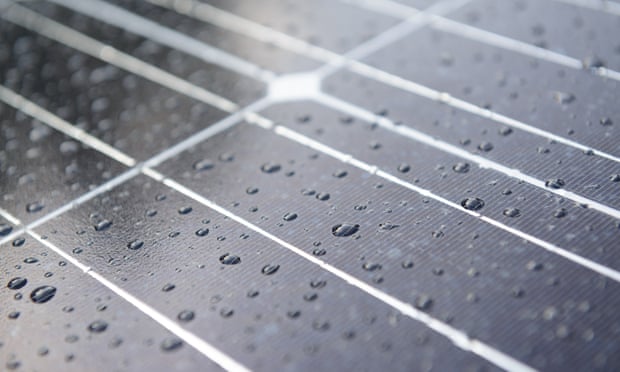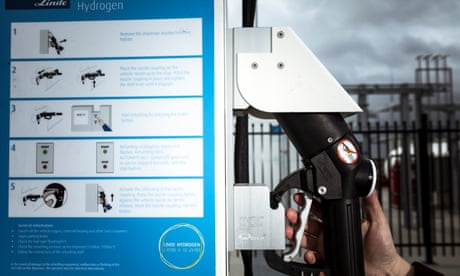Researchers say their prototype produces hydrogen with greater than 99% purity and works in air as dry as 4% relative humidity

University of Melbourne researchers say their new solar-powered
device can convert moisture in the air into 99% pure hydrogen gas.
Photograph: Getty Images
Donna Lu
THE GUARDIAN
Donna Lu
THE GUARDIAN
Tue 6 Sep 2022
Researchers have created a solar-powered device that produces hydrogen fuel directly from moisture in the air.
According to its inventors, the prototype produces hydrogen with greater than 99% purity and can work in air that is as dry as 4% relative humidity. The device would allow hydrogen to be produced without carbon emissions even in regions where water on land is scarce, they say.
Hydrogen is a zero-carbon fuel that yields only water as a byproduct when combusted. However, pure hydrogen is not abundant in nature and producing it requires energy input. Large-scale production commonly involves fossil fuels that generate carbon emissions.
What is hydrogen energy? And what's the difference between blue and green hydrogen? | News glossary
The study’s lead author and a senior lecturer in chemical engineering at the University of Melbourne, Dr Gang Kevin Li, said the hydrogen-producing device could be powered by solar or wind energy.
A prototype produced hydrogen for more than 12 consecutive days in a monitored trial. “[For] one of them, we left it to run by itself for eight months,” Li said.
The device is comprised of spongy material with a hygroscopic liquid – fluid that absorbs moisture from the air, similar in function to silica gel sachets. The absorbed water molecules are then split at electrodes into hydrogen and oxygen gasses, a process known as electrolysis.
Our Australian morning briefing email breaks down the key national and international stories of the day and why they matter
Privacy Notice: Newsletters may contain info about charities, online ads, and content funded by outside parties. For more information see our Privacy Policy. We use Google reCaptcha to protect our website and the Google Privacy Policy and Terms of Service apply.

Hydrogen fuel stations to be built between Sydney and Melbourne under $20m plan
The device is estimated to produce up to 93 litres of hydrogen a square metre an hour. “If you have 10 sq metres of this unit, you can power a whole house … to replace your consumption of natural gas at home for cooking and heating,” Li said.
The prototypes are still only small in size, and the team has plans to create 1 sq metre and 10 sq metres units in the coming year.
The researchers envisage the device could be a useful tool in regions where liquid water is not readily available for producing hydrogen. “Large parts of the world have water scarcity problems,” Li said. “When you have lots of renewable energy – wind or solar – you [often] don’t have much fresh water for this type of hydrogen production.”
Dr Kim Beasy of Swinburne University’s Victorian Hydrogen Hub, who was not involved in the research, said hydrogen fuel, while important, was not a silver bullet for reaching net zero. “We’re coming to understand that hydrogen is going to be one piece of the puzzle,” she said.

Queensland airline Skytrans unveils plans for Australia’s first hydrogen-fuelled plane
“It’s going to provide us with direction out of some pretty hard-to-mitigate industries such as transport. We have no alternative to diesel at the moment … hydrogen is a really good option.”
The required economies of scale were “probably not going to be reached with clean hydrogen straight away”, Beasy said, citing the expensive price of conventional hydrogen electrolysers. “What we really need is more government support and subsidies in bringing down the cost of getting this technology on the ground.”
The study was published in the journal Nature Communications.
Researchers have created a solar-powered device that produces hydrogen fuel directly from moisture in the air.
According to its inventors, the prototype produces hydrogen with greater than 99% purity and can work in air that is as dry as 4% relative humidity. The device would allow hydrogen to be produced without carbon emissions even in regions where water on land is scarce, they say.
Hydrogen is a zero-carbon fuel that yields only water as a byproduct when combusted. However, pure hydrogen is not abundant in nature and producing it requires energy input. Large-scale production commonly involves fossil fuels that generate carbon emissions.
What is hydrogen energy? And what's the difference between blue and green hydrogen? | News glossary
The study’s lead author and a senior lecturer in chemical engineering at the University of Melbourne, Dr Gang Kevin Li, said the hydrogen-producing device could be powered by solar or wind energy.
A prototype produced hydrogen for more than 12 consecutive days in a monitored trial. “[For] one of them, we left it to run by itself for eight months,” Li said.
The device is comprised of spongy material with a hygroscopic liquid – fluid that absorbs moisture from the air, similar in function to silica gel sachets. The absorbed water molecules are then split at electrodes into hydrogen and oxygen gasses, a process known as electrolysis.
Our Australian morning briefing email breaks down the key national and international stories of the day and why they matter
Privacy Notice: Newsletters may contain info about charities, online ads, and content funded by outside parties. For more information see our Privacy Policy. We use Google reCaptcha to protect our website and the Google Privacy Policy and Terms of Service apply.

Hydrogen fuel stations to be built between Sydney and Melbourne under $20m plan
The device is estimated to produce up to 93 litres of hydrogen a square metre an hour. “If you have 10 sq metres of this unit, you can power a whole house … to replace your consumption of natural gas at home for cooking and heating,” Li said.
The prototypes are still only small in size, and the team has plans to create 1 sq metre and 10 sq metres units in the coming year.
The researchers envisage the device could be a useful tool in regions where liquid water is not readily available for producing hydrogen. “Large parts of the world have water scarcity problems,” Li said. “When you have lots of renewable energy – wind or solar – you [often] don’t have much fresh water for this type of hydrogen production.”
Dr Kim Beasy of Swinburne University’s Victorian Hydrogen Hub, who was not involved in the research, said hydrogen fuel, while important, was not a silver bullet for reaching net zero. “We’re coming to understand that hydrogen is going to be one piece of the puzzle,” she said.

Queensland airline Skytrans unveils plans for Australia’s first hydrogen-fuelled plane
“It’s going to provide us with direction out of some pretty hard-to-mitigate industries such as transport. We have no alternative to diesel at the moment … hydrogen is a really good option.”
The required economies of scale were “probably not going to be reached with clean hydrogen straight away”, Beasy said, citing the expensive price of conventional hydrogen electrolysers. “What we really need is more government support and subsidies in bringing down the cost of getting this technology on the ground.”
The study was published in the journal Nature Communications.
No comments:
Post a Comment